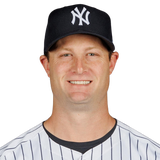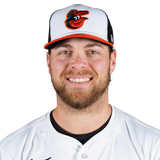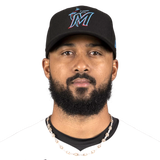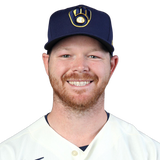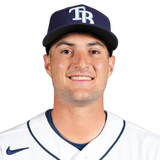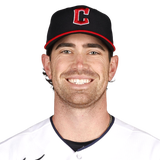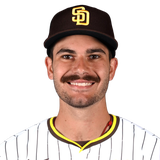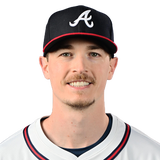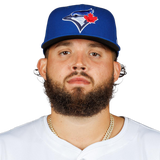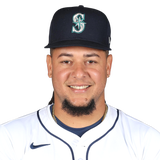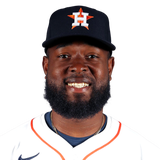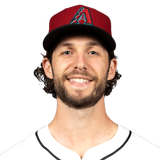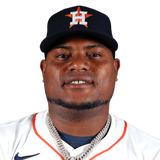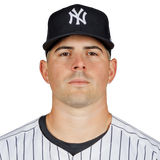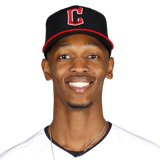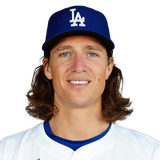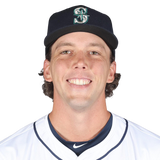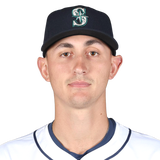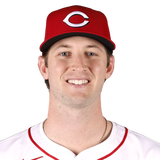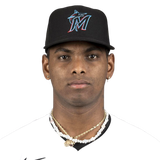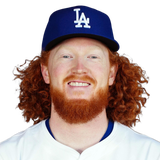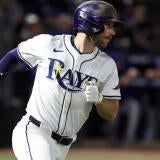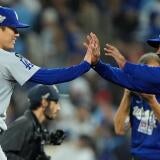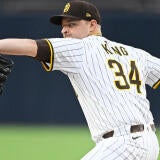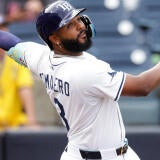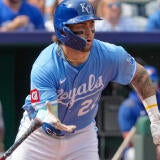2023 Fantasy Baseball Starting Pitcher Preview: Rankings, sleepers, busts, top prospects, and an ADP overview
A complete position breakdown on what you need to know before you draft
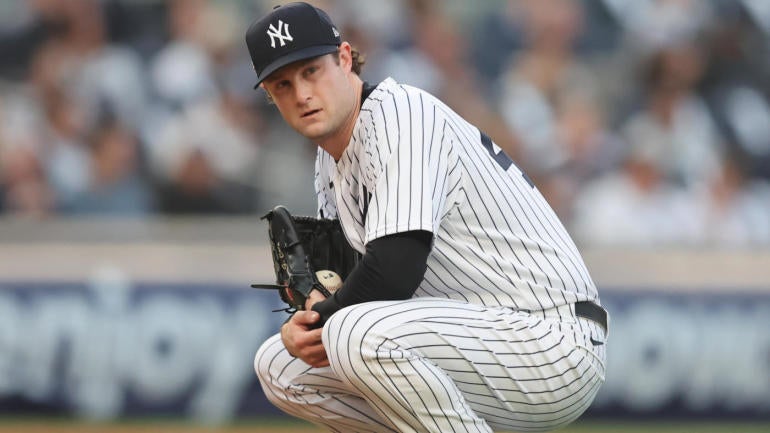
It's been a while since pitching was as cheap as it is in Fantasy Baseball drafts in 2023. The juiced ball era made it harder to find pitchers with good ratios, and other trends away from workhorse-type starters made the few who might conceivably get to 200 innings even more valuable, and you saw that in the way pitchers were valued in Fantasy drafts.
In 2022, we had two starting pitchers with an ADP inside of the top 12, and five inside of the first 24 picks – three and six if you count Shohei Ohtani, who can be used as both a hitter and pitcher in NFBC. Inside of the top 50, we had 12 starters going off the board. The trends in 2021 were similar; three inside of the top 12, eight in the top 24, and 14 in the first 50 picks.
Things have changed dramatically in 2023 drafts, at least at the top. Ohtani is the only pitcher with an ADP inside of the top 15, and Corbin Burnes (17.4) and Gerrit Cole (19.32) are the only other two inside of the first 29 picks; Sandy Alcantara is the No. 3 true SP at 29.34. Spencer Strider (32.93) and Jacob deGrom (32.95) are the only other pitchers taken on average in what would be the first three rounds of a 12-team league.
It's not hard to see why high-end pitching is cheaper than it has been in a long time. 19 pitchers qualified for the ERA tight in 2022 while posting an ERA below 3.00, the most since 22 did it in 2014. That's no coincidence, of course – the beginning of the juiced ball era has been pinpointed as the 2015 All-Star break, when bouncier balls were seemingly introduced into the game. MLB consciously introduced changed to the manufacturing process of the baseball, while also implementing rules making all 30 teams store their baseballs in uniform conditions with a humidor. That led to depressed offense (especially in April), and made it easier than it has been in a long time to find pitching help for Fantasy.
Investing early-round picks in pitching just doesn't make sense when guys like Shane McClanahan, Cristian Javier, Zac Gallen, and Triston McKenzie (among, well, many others) were available for cheap and made a big impact. 2022 might have been an outlier, in that regard, and maybe we'll look back at how cheap the high-end pitchers were this year and year from now and come to the conclusion that we overreacted to what we saw in 2022.
I think there's at least a chance of that happening, especially because there still just aren't many pitchers capable of throwing a ton of innings. Only 45 got to even 150 innings in 2022, the second-lowest of any season over the past decade, not including the shortened 2020 season; 27 got to 180 innings and only eight got to 200, both also the second-fewest of the past decade.
Finding pitchers who can put up good ratios and rack up big per-inning strikeout numbers was easy in 2022, sure. Finding guys who could do both of those things while providing a ton of innings was harder than just about ever. Of course, the bar for counting stats in Roto leagues is also lower as a result of that, but that just means that someone like Sandy Alcantara makes an even bigger impact on your ERA and WHIP than he would have in the past; if the denominator for calculating your ERA is lower, a pitcher who puts up an elite ERA over 225-plus innings is going to be even more impactful.
Which is why my strategy for 2023 Fantasy Baseball drafts has been to try to get one and preferably two of the rare pitchers who can give you legitimate ace production, both on a per-inning and with 180-plus innings over the course of the season. Getting two of those guys allows me the flexibility to take more chances with the rest of my pitching staff. I'll typically have two starters with my first six picks, and then I probably won't take another one until the double-digit rounds.
I won't do that in every draft, but that's my plan for starting pitcher, more or less.
However, I will note that there's still a lot of value in having at least one of those ace-level pitchers who you can also count on for a lot of innings. There's a wider middle class at SP right now than there was during the juiced ball seasons, which means it'll be relatively easy, at various points of the season, to find some streamer who won't blow up your ratios. You don't necessarily need to draft five starters in your first 100 picks to feel good about your staff.
The move to Yankee Stadium (and, allegedly, the sticky stuff crackdown) has made Cole less of a standout in ERA than he was at his best. Still, Cole is probably the odds-on favorite to lead the majors in strikeouts, he'll give you a great WHIP and a bunch of wins on a good Yankees team, and he has one of the best health track records at the position. Cole may not end up as the No. 1 pitcher, but there aren't many with his kind of floor.
| ||||||||||||||||||||
On a per-inning basis, Burnes is probably a better pitcher than Cole at this point, and the innings gap between them disappeared in 2022. He's probably not as sure a thing for 200 innings, and Cole should win more games, but Burnes is probably the better pitcher at this point. Either is a viable first-round pick in H2H points leagues, but you're better off waiting until the early second.
| ||||||||||||||||||||
Verlander came back from basically not pitching the prior two seasons and, as a 39-year-old, put up a historically great 1.75 ERA and 0.829 WHIP. It wasn't exactly like peak pre-injury Verlander, because he didn't get the kind of strikeout or inning totals we had gotten used to, but for a first year back from Tommy John surgery, it wasn't bad. There's always risk with a 40-year-old, but Verlander has aged as gracefully as just about any pitcher in history, and I wouldn't be shocked if we saw an uptick in his strikeout rate.
| ||||||||||||||||||||
Nearing the end of a career defined by consistency, Scherzer has dealt with a few nagging injuries over the past four seasons. Nothing serious, but enough that he hasn't reached 180 innings since 2018 – he had six straight with 200 innings prior to that. Despite that, Scherzer remains an ace when he's on the mound, even with some mild decline in his strikeout rate – which was a still-very-good 30.6% last season. At 38, Scherzer's decline could come soon, but given how well he's done holding it off so far, I don't really expect it at this point. You just might have to deal with an IL stint or two.
| ||||||||||||||||||||
Acantara may not have the strikeout abilities of some of the other big-name pitchers, and if the shift restrictions make it a bit tougher to rely on your defense for outs, he could be more negatively impacted than most. Of course, Alcantara probably has some room to increase his strikeout rate, given the quality of his stuff, so I'm not too worried about that – especially since he's always been one of the best in baseball at limiting damage on contact, shift or not. 2022 may go down as the best season of his career, but Alcantara should remain a very good pitcher moving forward.
| ||||||||||||||||||||
Woodruff is a very good pitcher, and on a per-inning basis, he's been one of the best in the league over the past half-decade or so. The problem is, he just hasn't had the innings. His 2021 total of 179.1 remains his career high, while 2020's shortened season is the only time he's ever been in the top-20 in the league. Woodruff has avoided serious injuries, so there's not too much risk here, necessarily, but it's held him back so far.
| ||||||||||||||||||||
deGrom's numbers over the past three seasons look like an elite closer's – 224.1 combined innings with 352 strikeouts (14.1 K/9), a 2.05 ERA, and a 0.731 WHIP. When he's on the mound, he's in a totally different galaxy from every other pitcher – he's approaching peak Pedro Martinez levels. However, he has dealt with injuries to his elbow, shoulder, forearm, and right side in that time, and he might not be built to stand up to how hard he throws nowadays. If deGrom does manage to throw even 150 innings this season, he might be the best pitcher in Fantasy, but that's something he hasn't done since 2019, so it's asking a lot. It's also not ideal that he's already dealing with tightness in his left side as spring training begins.
| ||||||||||||||||||||
McClanahan took the giant step forward we hoped he would last season, but a left shoulder injury in August introduced some uncertainty into his profile. His velocity was fine coming back from that, but he had a 4.50 ERA with just 17 strikeouts in 26 innings over his final five starts, which is a little alarming. McClanahan looked like one of the best pitchers in baseball last season, but it's an open question whether he's going to be able to hold up over a full season.
| ||||||||||||||||||||
Nola bounced back from a frustrating 2021, and he remains one of the most dependable sources of volume at the position. That's not to say he doesn't provide quality in addition to quantity, but Nola probably won't give you the per-inning brilliance of someone like McClanahan or deGrom. What he does give you is a rare pitcher with next to no injury history who can anchor your staff and allow you to take some more high-upside picks later.
| ||||||||||||||||||||
Wheeler is a lot like his teammate, Nola, except he does have a bit of a recent injury history, having missed time last spring with a shoulder issue and then in August with a forearm injury. He pitched well in the playoffs, throwing 35.2 innings of 2.78 ERA in six starts, so I'm not too concerned, but it's a small ding on his resume now.
| ||||||||||||||||||||
Because he throws near-100 mph fastballs, Ohtani carries a decent amount of risk, as we saw when he had Tommy John surgery a few years back. However, because he's pulling double duty as a hitter, he carries even more injury risk because of that. It hasn't stopped him from emerging as one of the best pitchers in baseball. There's a ceiling on how much value he can provide as a pitcher because he'll pitch every sixth day rather than every fifth, which means in most leagues, you're probably using him as a hitter. But as a pitcher, Ohtani is one of the best around on a per-inning basis, and is a fringe SP1.
| ||||||||||||||||||||
The question with Strider is whether he can make the leap to 170-plus innings without suffering injuries or seeing his effectiveness wane. He held up well to a starting role last season, but he's also being drafted as a top-12 starting pitcher without having proven he can handle the workload for a full season. There's huge upside here, but also not insignificant risk.
| ||||||||||||||||||||
Despite dealing with shoulder issues in 2021, Bieber more or less looked like himself in 2022, racking up big innings totals and an ERA below 3.00 with a very good WHIP. He probably won't ever replicate his elite strikeout rates from 2020 again, especially if he can't rediscover the nearly 3 mph he lost off his fastball since then, but he proved he can still be very effective at his current levels by leaning on his slider more than ever. Because his fastball still gets hit really hard, I think there will always be a relatively slim margin for error here with Bieber, but he hasn't lost it yet. I don't see why he would this season.
| ||||||||||||||||||||
Cease has always had the potential, and he finally got the results last season. He wasn't actually much different of a pitcher than the year before – his strikeout rate was actually 1.5 percentage points lower, while his walk rate was up 0.8 points. The biggest change for Cease was he went from being pretty below average in terms of quality of contact allowed to one of the best in the league. If he can sustain that, he should remain very good moving forward, but there's certainly some risk of regression here.
| ||||||||||||||||||||
Urias has consistently pitched like an ace, albeit without the strikeout numbers or innings totals we typically look for. The Dodgers might take a step back this season – relatively speaking – and that could be felt on the defensive side, especially. Urias could be more impacted by a defensive downgrade than most pitchers in this tier, though his strong quality-of-contact suppression makes him a pretty good bet to remain an ERA standout, even if he might not be quite as good as last season.
| ||||||||||||||||||||
Fried is like the east coast version of Urias. He doesn't stand out in strikeouts, but he makes up for it by generating a ton of weak contact – he ranked in the 92nd percentile in average exit velocity allowed last season. He also hasn't shown the ability to rack up massive innings totals yet, with his career high of 185.1 coming in 2022. If he can go consistently deeper into games, he could give you what Sandy Alcantara does, but Alcantara is a much more reliable source of volume at this point.
| ||||||||||||||||||||
There's a theme here: Manoah doesn't get a ton of strikeouts, but he keeps himself out of harm's way by limiting baserunners and hard contact. He isn't as proven as either Urias or Fried, but he's gotten closer to 200 innings than either, and showed more strikeout upside in 2021, too. If he can combine both, we could very well be talking about Manoah as a top-10 starter this time next year.
| ||||||||||||||||||||
The fact that Gausman still managed a 3.35 ERA despite a .363 batting average on balls in play is remarkable. For context, the next worst mark in the league came from teammate Jose Berrios, at .328. Gausman tended to give up a lot of loud contact, so it wasn't all bad luck, but even given that, I'd expect significant improvement in that regard. If he does that while maintaining a strikeout rate near 30% and elite control, he definitely has top-12 upside.
| ||||||||||||||||||||
It's been a real roller coaster ride for Castillo over the past few seasons, but we pretty much got the best version of him in 2022 once he returned from missing the first month or so with a shoulder injury. His inconsistent track record is a red flag, and there's some injury risk here too, but Castillo has borderline SP1 upside when he's right.
| ||||||||||||||||||||
At his best, Javier was literally unhittable – he had two different outings with at least six innings of no-hit ball, with five others of at least five innings and one hit. Javier had a .168 expected batting average against, so that was no fluke. The question is whether he can do it for a full 30-plus-start season – his 162.1 innings in 2022 (including playoffs) are by far the most of his career.
| ||||||||||||||||||||
Gallen dealt with an elbow injury in 2021 that had plenty of analysts and players avoiding him last season. That was a mistake, as he made 31 starts and was one of the best pitchers in baseball. You don't get the elite strikeout numbers from him, but he has a deep and varied arsenal, good control, and does a good job of limiting damage on contact. There's some lingering injury risk here, and Gallen may not have the upside to be a true ace without more strikeouts. But he's a more-than-capable No. 2 SP.
| ||||||||||||||||||||
The Astros have another version of peak Dallas Keuchel in Valdez, who induces groundballs at a massive rate. He does so with about average strikeout and walk rates, which is good enough, especially when his approach on the mound makes him a pretty good bet to be one of the league leaders in innings. 2022 was the first time he got to 200 innings, however he averaged better than six innings per start in 2021, with a finger injury limiting him to just 22 starts. Valdez isn't quite Sandy Alcantara – like Keuchel, his WHIP usually isn't quite as good as you'd like – but he's not far off.
| ||||||||||||||||||||
Darvish goes through stretches where he looks like the best pitcher in the world (2021), and then stretches where he looks completely lost. This might be a side effect of having such a deep and varied arsenal – it might be harder to make adjustments with so many moving parts. Still, the end result is usually pretty good – amid the ups and downs of the past few years, he has a 3.34 ERA and 1.007 WHIP with 10.1 K/9 over the past three seasons. That seems like a pretty good expectation for the 36-year-old.
| ||||||||||||||||||||
Given his lengthy injury history, staying healthy for one season doesn't guarantee that Rodon will remain healthy moving forward, and Rodon ended up suffering a forearm strain in spring training that puts his availability for the start of the season in question. It sounds like the injury isn't particularly serious, and he may only miss a turn or two in the rotation, so we haven't buried Rodon too far in the rankings. There's risk here, obviously, and more than expected due to the spring injury. But Rodon is a legitimate ace when healthy, and if he gives us another 180 innings this season, he's going to be a hugely impactful pitcher.
| ||||||||||||||||||||
Injuries threatened to derail McKenzie's career, but he's managed to stay healthy over the past two seasons and has refined his pitch mix to work for him. His curveball and slider are pretty good weapons, with the curveball the better strikeout pitch while the slider more of a pitch-to-contact weapon. The problem is, his fastball has a tendency to get hit pretty hard, and he throws it a majority of the time. It wasn't an issue last season, but his underlying metrics suggest there's some risk with how much he relies on the pitch. I like McKenzie, but I think 2022 was probably more of a best-case scenario than the new norm.
| ||||||||||||||||||||
Since getting traded to the Rays, Glasnow has a 3.05 ERA and 34.3% strikeout rate. He's a phenomenal pitcher, arguably one of the best in the league on a per-inning basis. The problem is, he's thrown just 268.1 innings over five seasons with the Rays, with recurring elbow and forearm injuries being the main reasons he's missed so much time. Coming back from Tommy John surgery, there's a lot of optimism around Glasnow, to the point where he often goes inside of the top-90 picks. That's a huge cost to pay for a guy who hasn't thrown more than 88 innings in a season since 2018 at this point. If he stays healthy, he's going to be awesome, but it just feels like a real long shot.
| ||||||||||||||||||||
Gilbert put together 185.2 innings of 3.20 ERA, and the peripherals mostly back it up. Given his age and experience level, he seems like a pretty safe bet to be a solid pitcher moving forward, but there are some real red flags in his profile worth talking about. Gilbert has a pretty deep arsenal, but doesn't necessarily have a reliable strikeout pitch, which wouldn't be much of a concern if he was better at limiting damage on contact. Unfortunately, he tends to give up pretty loud contact, leading to pretty average results on balls in play. Average strikeout rates and average quality of contact isn't a great combination, and that's reflected in a 4.11 xERA for Gilbert. I just don't see much reason to draft him at his price when guys like Logan Webb, Nestor Cortes, or Kyle Wright are all typically going around the same time, if not after him.
| ||||||||||||||||||||
If I'm going to chase one of the young Mariners pitchers, I'd go with Kirby over Gilbert, though they have somewhat similar limitations. Neither is a great strikeout pitcher, though Kirby was a hair better last season, while also boasting superior quality of contact metrics. Kirby is no sure thing to take a step forward – he's lacking a true putaway pitch – but I feel better about his chances than Gilbert's.
| ||||||||||||||||||||
A back injury kept Lodolo off the field for more than two months, and it took him a while to get right – he had a 4.30 ERA with just four quality starts over his first 13 starts as of the end of August. Something clicked over the final month, however, as he turned in 36.1 innings with a 2.48 ERA and 49 strikeouts over his final six starts. Lodolo relies pretty heavily on his two fastballs, which makes him a bit of an anachronism in today's game, but he's also got a very good curveball to put batters away with, and a changeup that helps keep righties honest. Lodolo is no sure thing, and his team and home park won't give him much help, but there's a lot to like if you want to take a chance in the middle rounds on a pitcher with upside.
| ||||||||||||||||||||
Of course, Greene is actually the more expensive of the two Reds breakout pick pitchers, and it makes sense in some ways. Fastball velocity is typically treated like a proxy for potential, and Greene has more fastball velocity than probably any starting pitcher in major-league history – 46% of all 100-plus mph fastballs by starting pitchers were thrown by Green last season, which remains arguably the most bonkers stat I've come across this offseason. The problem is, Greene's fastball wasn't actually a particularly good pitch last season. He got a bunch of whiffs with it, but it also ranked just 184th out of 225 pitchers' four-seam fastballs in run value, per Statcast, because he gave up 17 homers with the pitch. He also has just a show-me changeup, so there's a lot of pressure on his fastball taking a step forward for Greene to live up to expectations. The upside is sky-high, and Greene did give us a tantalizing taste of that when he had 37 strikeouts in 23 innings over his final four starts last season. I prefer Lodolo at a slightly cheaper price tag, but I get the Greene love.
| ||||||||||||||||||||
The Marlins don't do much right as an organization, but they've more than earned the benefit of the doubt from me when it comes to developing pitching. Cabrera reminds me a lot of a young Sandy Alcantara, and while that doesn't necessarily mean he'll make the same kind of leaps Alcantara did, it's not a bad guy to learn from. The biggest issue for Cabrera last season was control – his 11.3% walk rate was the eighth-highest among all pitchers with at least 70 innings in the majors. If he can shave a few points off that, there's incredible potential here – Cabrera had very good quality of contact metrics last season and three pitches with a whiff rate of at least 30%. There's a pretty lengthy injury history here as well, which is another red flag, though Cabrera's cheap enough that you can mostly overlook it. However, if he can stay healthy, Cabrera looks like a pretty solid pitcher already, with a potential ace-level outcome if he can keep the walks under control. It's a very exciting profile.
| ||||||||||||||||||||
I've made the Alcantara comp a few times before, but it may be most applicable to May, in terms of skill set. Like a young Alcantara, you watch May pitch and wonder how he doesn't get more strikeouts, but that misses the point of what makes him great. May's pitches have so much movement, with so much velocity, that it's basically impossible for hitters to square him up. That leads to a lot of poorly struck ground balls, hence a career 3.26 ERA compared to a 3.94 FIP. That kind of gap might actually be sustainable for May, and he's also shown signs of being able to ratchet up the whiffs, as he did in his brief beginning to the 2021 season. The Alcantara comp falls apart when it comes to innings expectations, especially on a team like the Dodgers, though he did average five innings per start in his return from Tommy John surgery last season on just 79 pitches, so there's some potential there, too. I don't have to squint too hard to see a top-15 outcome for May.
| ||||||||||||||||||||
As one of the hardest throwing starters in the game, armed with a wipeout slider that had the third-highest whiff rate among all pitchers last season (behind Jacob deGrom and Edwin Diaz), I don't have much concern about whether Strider is going to be good in 2023. He should continue to be very good, even if the changeup never becomes much more than a show-me pitch. However, I can't justify drafting Strider as a top-six starting pitcher, which is what his cost currently is in NFC drafts. Strider's 1334 innings last season represent his career high, and this is a Braves team with World Series aspirations. They could push him to 150 innings, maybe 160, in the regular season, but they're probably still going to have to be somewhat careful here. If he's as good as last season, even 160 innings would make him an SP1, but we simply don't know how he's going to hold up to that kind of workload over a full season, especially knowing he'll be starting from Opening Day, rather than opening out of the bullpen like he did last season. Strider looked like arguably the best pitcher on a per-inning basis last season, but doing that for a full-time starter's workload is a whole different beast.
| ||||||||||||||||||||
Starting Pitcher Top Prospects
1. Grayson Rodriguez, SP, Orioles
Age (on opening day): 23
Where he played in 2022: High-A, Double-A, Triple-A
Minor-league stats: 6-2, 2.62 ERA, 0.99 WHIP, 75 2/3 IP, 28 BB, 109 K
A lat injury that canceled his June debut was the first hiccup in an otherwise perfect climb to the big leagues, depicting a level of minor-league mastery not seen since maybe Jose Fernandez. With a fastball so good that he doesn't need a standout secondary, Rodriguez nonetheless offers three along with plus command and a workhorse build that will hopefully minimize future injuries.
Scott's 2023 Fantasy impact: fighting this spring
2. Andrew Painter, SP, Phillies
Age (on opening day): 19
Where he played in 2022: Low-A, High-A, Double-A
Minor-league stats: 6-2, 1.56 ERA, 0.89 WHIP, 103 2/3 IP, 25 BB, 155 K
Pitchers drafted out of high school aren't supposed to have it so easy. Pitchers who stand 6-feet-7 aren't supposed to throw so many strikes. Painter defied every convention in his first full professional season, climbing all the way Double-A before his 20th birthday while working deeper and issuing fewer walks at every stop. His final 12 starts saw him strike out 82 while walking only six.
Scott's 2023 Fantasy impact: late-season look
3. Eury Perez, SP, Marlins
Age (on opening day): 19
Where he played in 2022: Low-A, Double-A
Minor-league stats: 3-3, 3.97 ERA, 1.14 WHIP, 77 IP, 25 BB, 110 K
As improbable as Painter was, lightning struck twice with Perez, who also made it to Double-A as a 19-year-old and has remarkable control for someone so young and so tall (6-feet-8). The final numbers aren't as strong as Painter's, but if you take out the three starts leading up to Perez being shut down with a lat injury in August, his ERA drops to 2.74.
Scott's 2023 Fantasy impact: don't count on it
4. Daniel Espino, SP, Guardians
Age (on opening day): 22
Where he played in 2022: Double-A
Minor-league stats: 1-0, 2.45 ERA, 0.71 WHIP, 18 1/3 IP, 4 BB, 35 K
Espino's 2022 was short-lived, but his 17.2 K/9 when he did pitch -- in his first taste of Double-A, no less -- tells you everything you need to know about his upside. He's a bat-misser extraordinaire, delivering a classic fastball/slider pairing but at super-charged velocities. He needs to prove he can sustain it over a starter's workload, though, having yet to throw even 100 innings in a season.
Scott's 2023 Fantasy impact: midseason hopeful
5. Ricky Tiedemann, SP, Blue Jays
Age (on opening day): 20
Where he played in 2022: Low-A, High-A, Double-A
Minor-league stats: 5-4, 2.17 ERA, 0.86 WHIP, 78 2/3 IP, 29 BB, 117 K
Tiedemann is yet another 19-year-old who shoved all the way to Double-A, his fastball playing up due to the vertical approach angle and pairing perfectly with his tumbling changeup for big whiff totals. He never went beyond five innings and faces significant durability questions as a result, but at 6-feet-4, he's a reasonable bet to answer in the affirmative.
Scott's 2023 Fantasy impact: late-season look
6. Kyle Harrison, SP, Giants
Age (on opening day): 21
Where he played in 2022: High-A, Double-A
Minor-league stats: 4-3, 2.71 ERA, 1.13 WHIP, 113 IP, 49 BB, 186 K
Harrison struck out nearly 40 percent of the hitters he faced last year but still struggled with walks, particularly after his move up to Double-A in late May. His rising fastball and sweeping slider are two of the pitches most in demand right now and have evaluators salivating over his potential. Even just minimal improvement would make him another Blake Snell, but there's a chance for so much more.
Scott's 2023 Fantasy impact: midseason hopeful
7. Gavin Williams, SP, Guardians
Age (on opening day): 23
Where he played in 2022: High-A, Double-A
Minor-league stats: 5-4, 1.96 ERA, 0.95 WHIP, 115 IP, 40 BB, 149 K
A Dynasty darling at this time a year ago, Williams delivered on those hopes and then some in his first year as a professional, not only compiling a 1.96 ERA in a season spent mostly at Double-A but also allowing just a .173 batting average, the best mark in all the minors. His secondaries still need some work, but fastballs as good as his generally don't need much to go with them.
Scott's 2023 Fantasy impact: midseason hopeful
8. Taj Bradley, SP, Rays
Age (on opening day): 22
Where he played in 2022: Double-A, Triple-A
Minor-league stats: 7-4, 2.57 ERA, 1.04 WHIP, 133 1/3 IP, 33 BB, 141 K
Bradley is 22 spots behind the previous pitching prospect in these rankings and not a slam-dunk choice to be the next up, but he does offer stability at a notoriously fickle position. While the stuff rates well, his fastball/cutter combo is geared more for weak contact than strikeouts, which should work out fine in a post-juiced ball league but nonetheless feels like a concession of sorts.
Scott's 2023 Fantasy impact: midseason hopeful
9. Hunter Brown, SP, Astros
Age (on opening day): 24
Where he played in 2022: Triple-A, majors
Minor-league stats: 9-4, 2.55 ERA, 1.09 WHIP, 106 IP, 45 BB, 134 K
Major-league stats: 2-0, 0.89 ERA, 1.08 WHIP, 20 1/3 IP, 7 BB, 22 K
Brown was touted as a pitcher with wicked stuff but little idea where it was going, so then when he came up and threw 67 percent of his pitches for strikes (compared to 62 percent in the minors) ... well, suffice it to say he's one September call-up who improved his stock, so much that we should all be wondering how long Jose Urquidy can hold him off.
Scott's 2023 Fantasy impact: fighting this spring
10. Gavin Stone, SP, Dodgers
Age (on opening day): 24
Where he played in 2022: High-A, Double-A, Triple-A
Minor-league stats: 9-6, 1.48 ERA, 1.12 WHIP, 121 2/3 IP, 44 BB, 168 K
Traditional evaluation rubrics seem to underrate Stone, possibly because of his smallish size or work-in-progress slider, but his 1.48 ERA led all the minors and was no higher than 1.60 at any of his three stops. His pitches play up because of how well he tunnels them, and his changeup is a true showstopper, helping to explain his 18 percent swinging-strike rate.
Scott's 2023 Fantasy impact: midseason hopeful


